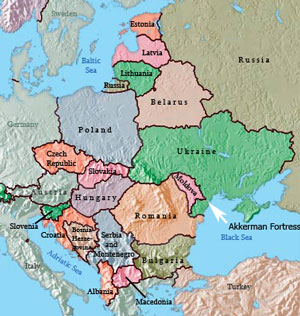 |
||||||
| Magazine | Advertising | Calendar | LA Screenings | Archives | Newsletters | Contact Us |
Central And Eastern Europe by the NumbersBy Bob Jenkins Here’s a question worth asking: Just how significant a medium is television in Central and Eastern Europe (CEE)? One way to ascertain the answer is to look at television’s share of advertising revenue in the region, which encompasses 20 countries.  According to Central and Eastern Europe Market and Media Facts 2008 — the most recent report from ZenithOptimedia, an ad agency with offices in 70 countries — television took 53.4 percent of the total regional advertising spend of US$30.3 billion in 2007, or more than three times the share of the second place medium, newspapers (16.6 percent) and well ahead of the Internet (2.9 percent). Even though Zenith included Turkey and Greece in this region, these countries were excluded for this article. Interestingly, in many of the larger territories of the DISCOP East region, television’s share is below the regional average. In the Czech Republic, for example, its take is just 46.1 percent, or approximately US$1.2 billion. In Russia, television claims a 49.2 percent share, roughly US$4.4 billion. In Poland, it has 50.6 percent of the market worth US$1.275 billion. While in some of the up-and-coming markets, such as Croatia (66.5 percent, or US$673 million) and Serbia (84 percent or US$1.07 billion), it is the leading medium, in some parts of Central and Eastern Europe, television is very much the poor cousin. In Latvia, television’s market share is only 34.8 percent (US$64 million), and the medium’s regional nadir is Estonia, where its share is just 26.7 percent (US$41 million), just over half the share of newspapers. Both the biggest and smallest territories brought the average down. What made the average go up were the middle range territories. In terms of how individual broadcasters fared in 2007, Russia’s most successful was Pervy Kanal, which netted US$2.6 billion with a 21 percent share of the total audience and 21.9 percent of adults. Next was Rossiya, which grabbed US$1.94 billion off the back of a 17 percent share of the total audience and 17.9 percent of adults. At the bottom of the Russian earnings table was Zvezda with US$13 million, and a 0.7 percent share of both total audience and adults. Pervy Kanal dominated the ratings, with nine out of the 10 most popular programs broadcast in 2007 (the survey was published in 2008, so the figures are for 2007), but lost the top spot in terms of ad minutes per week to MTV, which clocked 1,555 per week versus 1,437 for Pervy Kanal (which actually places the latter in third place behind TV-3, which has 1,482). With US$692 million, Polsat was Poland’s biggest earner, but, with an overall audience share of 16.8 percent and 16.2 percent of all adults, its audience share fell short of both TVP1 (23.2 percent of individuals and 23.4 percent of adults) and TVP2 (18 percent and 18.5 percent, respectively). On the basis of these shares, TVP1 netted US$480 million, and TVP2 US$335 million. But even these numbers didn’t earn either channel second place in the Polish market. That honor went to TVN, whose audience share of 16.5 percent overall, and 16.8 percent amongst adults was parlayed into a total advertising haul of US$672 million. Bottom of the Polish revenue league was TV Polonia whose audience share of 0.7 percent in both categories was only worth US$310,000, although it did win a bigger share of the audience than Discovery Science, Discovery Civilization, Canal +, VH1 Polska, Zone Reality 4Fun TV, Polsat Sport Extra, Canal + Sport, Zone Romantica, Kuchnia.tv and Travel Channel, all of which were unable to attract more than 0.1 percent of the audience. In terms of ad minutes per week, very little divided the top two channels, with TV4 registering 1,683, just four minutes a week ahead of Polsat with 1,679. TVN was in third place with 1,470 minutes, just narrowly beating fourth-place TVN7’s 1,397. Leading the dash for cash in the Czech Republic was Nova, with a haul of US$266 million. It also grabbed the largest slice of the audience with 39.6 percent in both categories. Prima was the next biggest earner with US$189 million, but its audience share, 19.1 percent overall and 19.4 percent of adults, was bested by state broadcaster CT1, which won over 22.7 percent of Czech viewers in both categories, but took only US$71 million in advertising. But then it only carried 76 minutes per week of advertising against 1,512 carried by 12 other broadcasters including both Nova and Prima. (Note: These don’t add up to 1.2 billion because there are a total of 22 channels that contribute to the total. We only picked highlights.) There has been much talk of late of the coming of the Internet to Central and Eastern Europe, but in 2007, access was at best patchy. While low figures are to be expected from countries such as Armenia, which recorded the lowest level of Internet access (with just seven percent of Armenians having access), even in the region’s dominant market, Russia, only 12 percent of the population managed to have access to the net in 2007. Top of the CEE’s league for access to the Internet was Estonia, with 57 percent of Estonians having easy access — which maybe one reason why so few watch television. But Estonia is only slightly ahead of Slovenia — where 56 percent are online — with Latvia not far behind at 49 percent. In Hungary, 43 percent of the population has access, Bulgaria and the Czech Republic stand at 41 percent, and Croatia is 40 percent wired, with Poland trailing closely behind at 32 percent. |
||
© 2009 Video Age International |
||